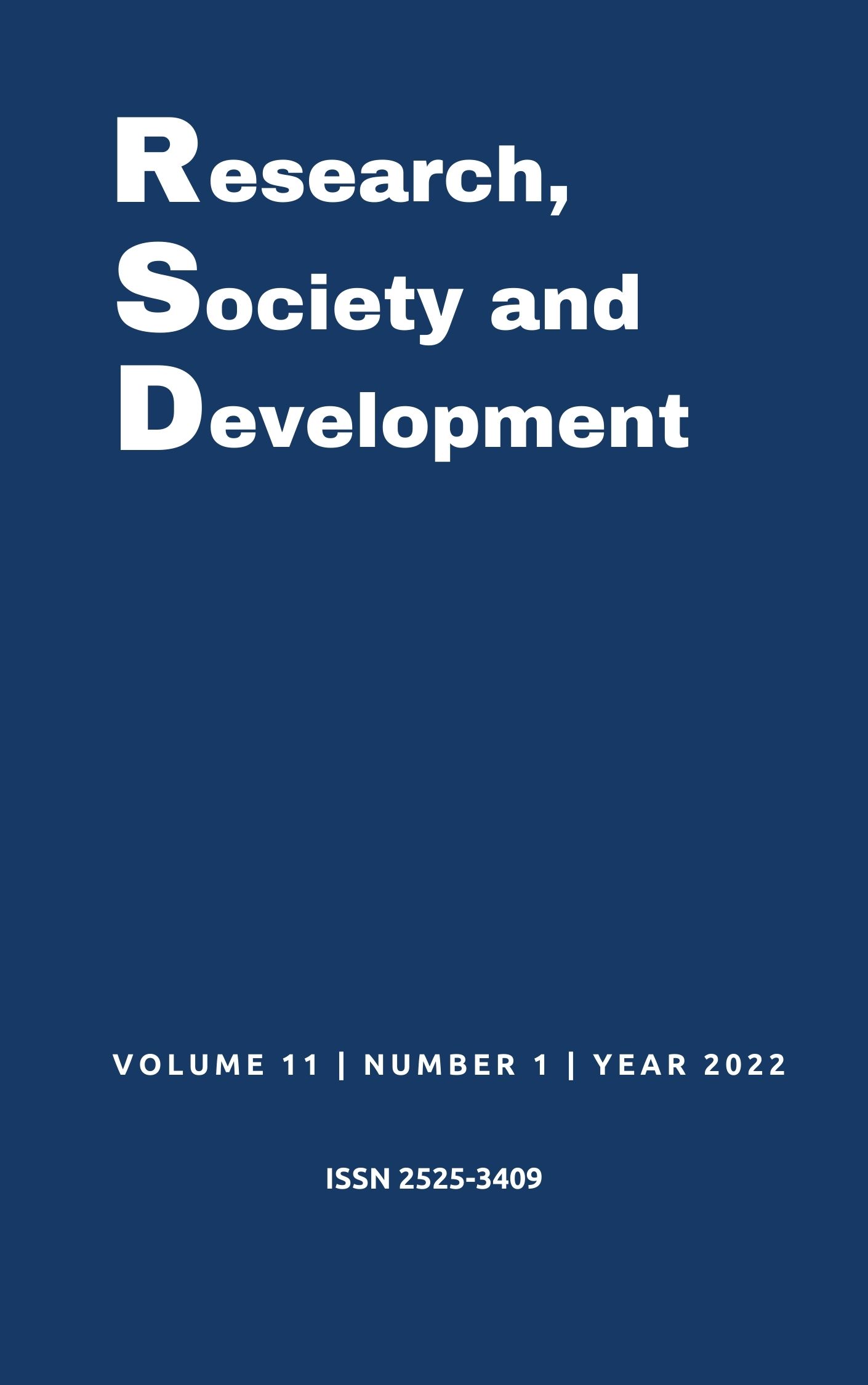Factors that increase the incidence of mortality due to brain vascular accident
DOI:
https://doi.org/10.33448/rsd-v11i1.24866Keywords:
Stroke; Mortality; Emergency.Abstract
Stroke is one of the main causes of hospitalizations and mortality, measuring its magnitude as a public health problem. It presents cognitive and neuromuscular changes that can manifest in two ways: ischemic and hemorrhagic. The objective of this work was to identify in the literature the factors that can increase the incidence of stroke mortality in Emergency Units (UE). This is a systematic review study whose descriptors used were: Stroke; Mortality and Emergencies. Complete articles were used that addressed the theme, published in the last ten years in Portuguese and English. Analysis of the articles was obtained through a careful reading of their titles, abstracts and contents. In sequence, the research sample consisted of eleven articles, being cataloged in an adapted document analysis file and organized as follows: journal / year; title; author (s); study objective; method; main results and conclusion. After categorization, a descriptive analysis of the data was performed. The results of this study allowed us to determine that other risk factors are little discussed, but they increase the possibility of stroke mortality. These results point to the need for intervention in several fields: qualification of people, use of strategies and tools that reduce the response time to start assisting stroke victims, as well as training directed to the population, with the objective of early recognition of stroke.
References
Araújo, J. P. et al (2018). Tendência da mortalidade por Acidente Vascular Cerebral no Município de Maringá, Paraná entre os Anos de 2005 a 2015. Int J Cardiovasc Sci. 31(1), 56-62.
Avelar, V. L. L. M., Paiva, K. C. M. (2010). Configuração identitária de enfermeiros de um serviço de atendimento móvel de urgência. Rev Bras Enferm. 63(6), 1010-1018.
Brasil. Ministério da Saúde. (2017). Banco de dados do Sistema Único de Saúde – DATASUS. Sistema de informação sobre mortalidade. Brasília: Ministério da Saúde.
Brasil, Ministério da Saúde. (2012). Portaria n° 664, de 12 de Abril de 2012. Protocolo Clínico e Diretrizes Terapêuticas: Trombólise no Acidente Vascular Cerebral Isquêmico Agudo. Brasília: Ministério da Saúde.
Brasil. Ministério da Saúde. (2002). Portaria nº 2048 GM/MS de 5 de novembro de 2002. Dispõe sobre a regulamentação do atendimento das urgências e emergências. Brasília: Ministério da Saúde.
Castro, J. A. B. et al (2009). Estudo dos principais fatores de risco para acidente vascular Encefálico. Rev Bras Clin Med. 7, 171-173
Costa, J. S. D. et al (2015). Complicações da Síndrome Coronariana e de Acidente Vascular Encefálico em Estudo de Coorte. Int J Cardiovasc Sci. 28(5), 377-384.
Lopes, J. M. et al. (2016). Hospitalização por acidente vascular encefálico isquêmico no Brasil: estudo ecológico sobre possível impacto do Hiperdia. Rev Bras Epidemiol. 19(1), 122-134.
Luz, C. C. et al. (2010). Análise da atenção pré-hospitalar ao acidente vascular Cerebral e ao infarto agudo do miocárdio na população idosa de Minas Gerais. Rev Assoc Med Bras. 56(4), 452-7.
Maniva, S. J. C. F. & Freitas, C. H. A. (2012). Uso de alteplase no tratamento do acidente vascular encefálico isquêmico agudo. O que sabem os enfermeiros? Rev Bras Enferm. 65(3), 474-81.
Miranda, R. D. et al. (2009). Hipertensão sistólica isolada e risco associado ao acidente vascular encefálico: implicações para o tratamento. Rev Bras Hipertens. 16(1), 29-33.
Prudêncio, R. S.; Ceretta, L. B.; Soratto, M. T. (2016). Assistência de enfermagem frente ao paciente com acidente vascular encefálico no setor de emergência. Enfermagem Brasil. 15(4), 190-197.
Reis, M. F. et al. (2018). Análise do gasto ambulatorial do Acidente Vascular Cerebral na perspectiva do sistema público. J Bras Econ Saúde. 10(3), 219-25.
Rolim, C. L. R. & Martins, M. (2011). Qualidade do cuidado ao acidente vascular cerebral isquêmico no SUS. Cad. Saúde Pública. 27(11), 2106-2116.
Santos, A. A. et al. (2019). Percepção de enfermeiros emergencistas acerca da atenção e preparo profissional. Rev enferm UFPE on line. 13(5), 1387-93.
Santos, J. V. S. et al. (2017). Os efeitos da capacitação de enfermeiros sobre avaliação de pacientes com acidente vascular cerebral. Rev Enferm UFPE on line. 11(5), 1763-1768.
Schmidt, M. H. et al. (2019). Acidente Vascular Cerebral e diferentes limitações: uma análise interdisciplinar. Arq. Ciênc. Saúde UNIPAR. 23(2), 139-144.
Silva, D. N. et al. (2019). Cuidados de enfermagem à vítima de acidente vascular cerebral (AVC): Revisão integrativa. Revista Eletrônica Acervo Saúde, (36), e2156.
Valle, G. S. do et al. (2020). Avaliação do grau de concordância do Protocolo Estadual de Classificação de Risco no Estado da Bahia -Brasil. Research, Society and Development. 9(11), p. e72591110297.
Zhang, Y. et al. (2012). The incidence, prevalence, and mortality of stroke in France, Germany, Italy, Spain, the UK, and the US: a literature review. Stroke Res Treat 2012.
Downloads
Published
How to Cite
Issue
Section
License
Copyright (c) 2022 Érica Simões Aguiar ; Vânia Alves Spinola; Mariane Teixeira Dantas Farias; Simone Santos Souza; Fabrícia Cristine Santos Leite; Gicelio Marques da Silva Junior; Igor Ferreira Borba de Almeida; Marilaine Matos de Menezes Ferreira; Paulo de Tassio Costa de Abreu

This work is licensed under a Creative Commons Attribution 4.0 International License.
Authors who publish with this journal agree to the following terms:
1) Authors retain copyright and grant the journal right of first publication with the work simultaneously licensed under a Creative Commons Attribution License that allows others to share the work with an acknowledgement of the work's authorship and initial publication in this journal.
2) Authors are able to enter into separate, additional contractual arrangements for the non-exclusive distribution of the journal's published version of the work (e.g., post it to an institutional repository or publish it in a book), with an acknowledgement of its initial publication in this journal.
3) Authors are permitted and encouraged to post their work online (e.g., in institutional repositories or on their website) prior to and during the submission process, as it can lead to productive exchanges, as well as earlier and greater citation of published work.

